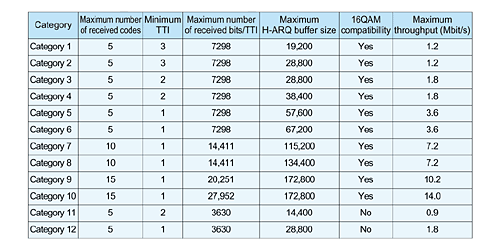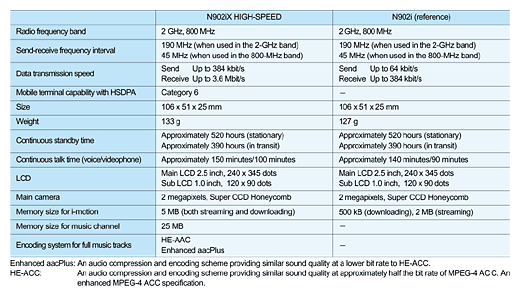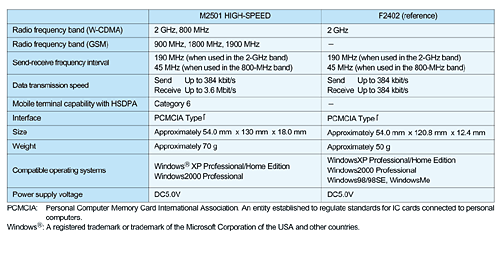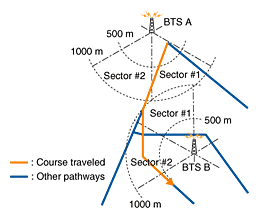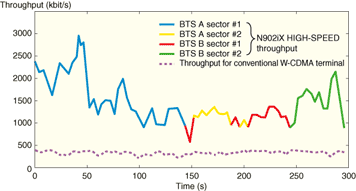 |
|||||||||||||||||||||||||||||||||||||||||||||||||||||
|
|
|||||||||||||||||||||||||||||||||||||||||||||||||||||
Vol. 5, No. 4, pp. 35–41, Apr. 2007. https://doi.org/10.53829/ntr200704sf5 HSDPA Terminal Development and Radio Transmission PerformanceAbstractThis article outlines two new mobile terminals developed for the HSDPA (high-speed downlink packet access) service. One is a mobile phone designed for high-speed communications, which has new functions such as music download. The other is a card-type terminal for portable computers aimed at business users. Radio transmission throughput performance based on field experiments is also reported. 1. IntroductionIn response to demands from users of its FOMA service for greater capacity and higher communication speeds, NTT DoCoMo commenced a commercial high-speed downlink packet access (HSDPA) service in August 2006. This service has a maximum data download speed of 3.6 Mbit/s. At the same time, a new telephone-type mobile terminal, the FOMA N902iX HIGH-SPEED (Fig. 1), and a card-type mobile terminal for use in portable computers, FOMA M2501 HIGH-SPEED (Fig. 2), were put on sale. The N902iX HIGH-SPEED is compatible with DoCoMo's new music program download service (Music ChannelTM) and supports a music download service and high-volume file transfer (up to 5 MB) using DoCoMo's i-motion*1 service. The M2501 HIGH-SPEED, which is aimed at business users, supports HSDPA/3G roaming and GSM*2. This article outlines the major points in the development of each of these HSDPA mobile terminals and describes the radio transmission throughput*3 performance based on field experiments.
2. HSDPA mobile terminal categories and maximum throughputThe 3rd Generation Partnership Project (3GPP) classifies HSDPA mobile terminals into 12 categories according to their data transmission capability, as listed in Table 1 [1]. The maximum number of received codes is the number of multiplexed codes on the high-speed physical downlink shared channel (HS-PDSCH) [2] that receives data. The minimum transmission time interval (TTI) is the minimum time interval allocated to the mobile terminal for receiving data. The values in the table indicate multiples of the minimum TTI of 2 ms. The maximum buffer size for hybrid automatic repeat request (H-ARQ)*4 is determined considering signals received prior to resend and resent signals; it is the maximum number of bits in the receive buffer after demodulation [3]. Categories 1-10 support 16QAM (16 quadrature amplitude modulation)*5. The maximum throughputs for categories 6, 8, 10, and 12 are 3.6, 7.2, 14, and 1.8 Mbit/s, respectively. As listed in Table 1, for categories 1-10, the maximum throughput increases as the maximum number of received codes increases or as the minimum TTI decreases. This requires a corresponding increase in the maximum buffer size for H-ARQ, and since the signal processing function becomes more complex, the mobile terminal requires higher capabilities. To strike a good balance between achievable throughput and signal processing complexity, DoCoMo commenced its service with Category 6, which has a throughput of 3.6 Mbit/s. This means that the mobile terminals must be able to demodulate up to five code-multiplexed signals, perform high-speed signal processing with a minimum TTI of 2 ms, and support 16QAM. Table 1. HSDPA mobile terminal categories.
3. Overview of HSDPA mobile terminals3.1 N902iX HIGH-SPEEDThe N902iX HIGH-SPEED mobile terminal is based on the N902i and shares, as much as possible, the component layout and chassis components. Its basic specifications are listed in Table 2. To support high-speed packet communication, the communications CPU (central processing unit) has been changed and an HSDPA-compatible accelerator*6 has been added. A dedicated memory (3.75 Gbit) has been added to store the content downloaded from the Music ChannelTM*7 and other music contents downloads. Power consumption has increased somewhat due to the addition of new hardware, but improvements made to the sleep function of the application CPU have resulted in a standby/talk time equal to or better than that of the N902i. The major development points are:
The music player can handle three types of content: (1) downloaded music contents, (2) music tracks stored on miniSD memory cards [4] with SD-Binding*8 [5] (SD: secure digital), and (3) music copied from commercial CDs using ripping software and stored in SD-Audio format. It also supports playlists and can display album cover art and song lyrics. Moreover, an enhanced range request*9 function [6] allows the user to reacquire lost content following a failure or interruption during a Music Channel download (25 MB), a music content download (up to 5 MB), or i-motion download (up to 5 MB). Table 2. Basic specifications of N902iX HIGH-SPEED.
3.2 M2501 HIGH-SPEEDIn addition to providing high-speed packet communication using HSDPA, the M2501 HIGH-SPEED is the first FOMA card-type mobile terminal compatible with international roaming. It works with both UMTS (universal mobile telecommunications system)*10 and GSM/GPRS*11 (GPRS: general packet radio service), so it can be used in more than 132 countries. It has a multiband-compatible internal antenna: 800 and 2100 MHz for HSDPA/UMTS and 900, 1800, and 1900 MHz for GSM/GPRS. The utility software provided supports voice communication, a phonebook, and communications status display. In addition, various network service settings such as an answer-phone service are available to improve usability. Table 3. Basic specifications of M2501 HIGH-SPEED.
4. HSDPA handover and mobile terminal throughput performance4.1 HSDPA handoverHSDPA is based on technologies such as adaptive modulation and coding (AMC), H-ARQ for retransmitting and combining packet data, and base transceiver station (BTS) scheduling for controlling the allocation of users. It can support peak data rates beyond 10 Mbit/s [7]. Since these technologies require a constant one-to-one connection between the HSDPA mobile terminal and the BTS, hard handover is essential in addition to soft handover*12 used in the conventional W-CDMA system. In hard handover, the destination BTS is selected each time the cell changes. The HSDPA handover procedure is as follows: 1) The quality level of the common pilot channel (CPICH) sent at fixed power from a cell in the vicinity is measured by the mobile terminal. 2) If a CPICH has a quality level exceeding a fixed threshold (reported by the network as a parameter) in relation to the handover source cell CPICH quality level, the relevant cell is reported to the radio network controller (RNC)*13. (If multiple cells exceed the threshold value, the cell with the highest quality level is reported.) 3) The RNC sets up the handover destination cell based on the report sent from the mobile terminal and issues a handover notification to the mobile terminal. 4) The mobile terminal receiving the handover notification disconnects from the handover source cell and connects to the handover destination cell. In accordance with this procedure, the HSDPA mobile terminal selects and reports cells having a satisfactory reception level and repeats the handover in accordance with instructions issued from the RNC to move between cells.
4.2 HSDPA mobile terminal throughput performanceThe throughput performance of the HSDPA mobile terminal has been measured in an actual field environment while the terminal moved from one BTS to another. A 2.5-km course between BTSs A and B was traveled at a speed of 30 to 40 km/h (Fig. 3). The throughput performances over time for the N902iX HIGH-SPEED and the conventional W-CDMA terminal are shown in Fig. 4. Each mobile terminal was connected to a personal computer. Then, after it had accessed a content server, a large file was downloaded using file transfer protocol (FTP)*14 and the throughput of the transmission control protocol (TCP) layer averaged over 4 seconds was measured. The blue, yellow, red, and green lines in the graph indicate throughput when connected to BTS A sectors #1 and #2 and BTS B sectors #1 and #2, respectively, while the purple dashed line indicates throughput for the conventional W-CDMA terminal. The changes in received signal code power (RSCP)*15 over time for sectors #1 and #2 of BTSs A and B are shown in Fig. 5. In the first stage (0-50 s) of the measurement course, that is, under line-of-sight propagation conditions for BTS A sector #1, the characteristics were satisfactory (1.5-2.9 Mbit/s). However, as the mobile terminal moved, the signal power (or interference waveforms) from other cells increased and throughput deteriorated (50-140 s). The received signal level for BTS B sector #1 exceeded that of BTS A sector #1 at an elapsed time of approximately 140 s, and while throughput temporarily spiked downwards, the transition of the handover to the destination BTS improved the received signal level. In addition, after 150 s, hard handover (in which the destination BTS was switched in response to the received level from the BTS) was repeated, and movement continued with the throughput being varied to suit the radio environment. Since the transmission power of the conventional W-CDMA terminal is controlled to maintain a constant level of received signal quality, throughput remained constant irrespective of the received signal level from the BTS. Average throughput obtained with the N902iX HIGH-SPEED on this course was 1.4 Mbit/s—an improvement by a factor of approximately 3.8 times compared with the conventional W-CDMA terminal.
5. ConclusionThis article outlined the characteristics of the N902iX HIGH-SPEED and M2501 HIGH-SPEED mobile terminals for HSDPA service, which commenced in August 2006. It also described HSDPA handover and clarified the throughput performance during handover based on a field experiment using the N902iX HIGH-SPEED. The experimental results for average throughput obtained by the testing station on a test course show that the throughput of the N902iX HIGH-SPEED was approximately 3.8 times better than that of the conventional W-CDMA terminal. Topics currently under investigation include supporting higher HSDPA categories for greater speed and introducing high-speed uplink packet access (HSUPA). References
|
|||||||||||||||||||||||||||||||||||||||||||||||||||||










